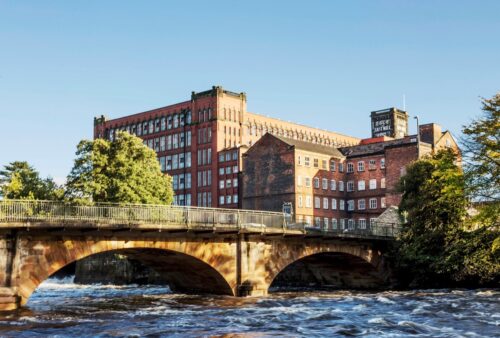Finding a New Future for Belper’s Beautiful Challenging Mills

Working with huge Grade 1 and Grade 2 listed mill buildings is both a joy and a challenge, and we spend quite a lot of our time working on projects of this type.
We first started working on the Belper Mills complex back in 2020, so when we were appointed again by The Derwent Valley Mills World Heritage Site (DVMWHS) Partnership for a second study last year, we went into it with delight, but also with our eyes open. We knew just how lovely the setting is and how significant these magnificent buildings are, not just to local people but also to the nation. But we also knew all about the complexities which underpin its recent history, its current use and the long standing planning application, lodged by the site owners, which has been under consideration by Amber Valley Borough Council since 2018. Our proposal, to develop an alternative scheme for the site therefore was to go right back to basics and examine, with fresh eyes and a realistic perspective, a mix of uses which would be appropriate for the buildings, for the town and for the World Heritage Site as a whole.
For the study we brought together a team of knowledgeable friends – Mosedale Gillatt conservation architects, Aspinall Verdi commercial property consultants and Appleyard and Trew Quantity Surveyors – a team that has worked together on many ‘tricky’ but interesting heritage projects over the years.
One of the things that we genuinely enjoyed about this work (alongside having the chance to work once again with a committed and highly engaged client team and wider steering group), was the opportunity that it provided us with to explore sectors and uses that we don’t normally get to consider – in particular modern industrial uses that could potentially provide the 21st Century equivalent of their original purpose. Rather sadly, having explored a number of such uses, talking to sector experts and assessing building and market requirements, none emerged as viable options for the future of the site, for a range of different reasons. But the thorough process that we went through did ensure that the short list of viable opportunities that we were eventually able to test through public consultation was one that we all had confidence in.
In the end, the preferred options were probably no great surprise. You can read about them here: Belper Mills Future – Derwent Valley Mills. But there were a number of things that were, without doubt, highly valuable to the Partnership. Our study was able to indicate a mix and scale of use that has the best chance of being viable meanwhile allowing us to test the response to, and viability of, some fairly radical alternatives. It also provided a realistic conservation deficit cost (a figure which recognises the difference in cost between delivering a fully commercial scheme compared to delivering it on a heritage site). The gap, inevitably, is significant! The process also provided a valuable forum for our colleagues at Derbyshire County Council to engage with local residents and stakeholders to understand how the site can best add value to its community in the future.
So what happens now? Well, change is not going to happen on the site any time soon. The planning application still needs to be determined and eventually significant levels of public funding will need to be found, alongside large amounts of commercial development funding. But our work, and everything that went into it, will play a role in ensuring that sound decisions can now be made in helping the site to move into the next phase of its long existence. We look forward to it….